#nathalie micas
Explore tagged Tumblr posts
Text
Rosa Bonheur, vrouwelijk kunstenaar met de broek aan, maakt er een Beestenboel van in Museum De Mesdag Collectie
Ontdek in TOOS&ART de intrigerende wereld van 19e eeuwse Rosa Bonheur, de vrouw die met dieren, kunst en de broek aan geschiedenis schreef. Nu te zien in Museum De Mesdag Collectie. Een eerbetoon aan een vergeten vrouwelijke meester! #Kunst #Museum
Rosa Bonheur op oudere leeftijd ‘t Staat al veel te lang op mijn lijstje voor Parijs. Maar ja, ik ben dan ook al veel te lang niet in Parijs geweest. Onfatsoenlijk lang. Te druk, druk, druk, zoals dat tegenwoordig heet. Wat daar dan op dat lijstje staat? Onfatsoenlijk veel. Maar hoe dan ook een bezoek aan het Château de By in Tomery, net buiten Parijs. Vanaf 1859 woonplek/atelier van kunstenaar…
#19e-eeuwse kunst#animalier kunst#Anna Klumpke#Atelier Rosa Bonheur#beroemde vrouwelijke kunstenaars#blog over kunst en cultuur#Château de By#Dierenschilderijen#feminisme in de kunst#Franse kunst#Hendrik en Sientje Mesdag#keizerin Eugénie#kunstblog TOOS&ART#kunstcollecties Nederland#kunstexposities Nederland#kunstgeschiedenis#Metropolitan Museum of Art New York#Musée d&039;Orsay Parijs#Museum De Mesdag Collectie#Museumtips Den Haag#Nathalie Micas#Panorama Mesdag#Parijs kunstbestemmingen#Parijse veemarkten#Ploegen in Nevers#Ridder in het Legion d&039;honneur#Rosa Bonheur#Scheveningen#schilderijen van dieren#tentoonstelling De Mesdag Collectie
0 notes
Text
I know I spent two days without posting any lesbian pride post lol but I swear I'm gonna post two posts per day in the following days to make up for it. I am again going to talk about an artist, but from a different period this time.
Rosa Bohneur !
(I love her name by the way... Bohneur means happiness in french and that's such a pretty name to have)
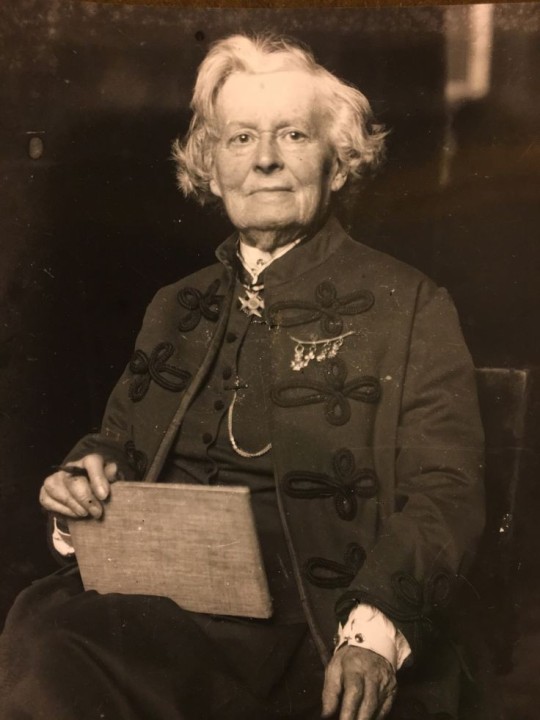
Marie-Rosalie Bonheur, known as Rosa Bonheur, was born in 1822 in Bordeaux and died in 1899 in Thomery. She was a French painter and sculptor specialising in representations of animals.
She has kind of an interesting family story (mother adopted by a rich guy who found out later who was her real father, siblings all artists, father who met a lot of interesting people, links with many famous people...) but it would be too long to talk about it and I want to focus on Rosa herself. Do check it up if you're interested!
During her youth, Rosa Bonheur had a reputation for being a tomboy, a reputation that followed her throughout her life and which she made no attempt to deny, wearing her hair short and later smoking cigarettes and cigars. Her emancipated lifestyle never caused a scandal, even though she lived in an era that was very concerned with convention. Like all women of her time, Rosa Bonheur had to apply to the Prefecture of Paris for a cross-dressing permit, renewable every six months, in order to wear trousers, in particular to attend livestock fairs, travel or ride horses.
Here's one of her permits, from 1857 :

And though many historians tried to deny the fact that she was a lesbian, she always refused to marry a man, has only ever had relationships with women and literally wrote that she never felt any sort of love, attraction or tenderness for men, "besides a frank and good friendship for those who had all my esteem". After the death of the woman she loved, she also wrote "If I'd been a man, I'd have married her, and they wouldn't have made up all those silly stories..." You got it : even if she didn't shout it from the rooftops, Rosa was very probaby a homosexual woman.
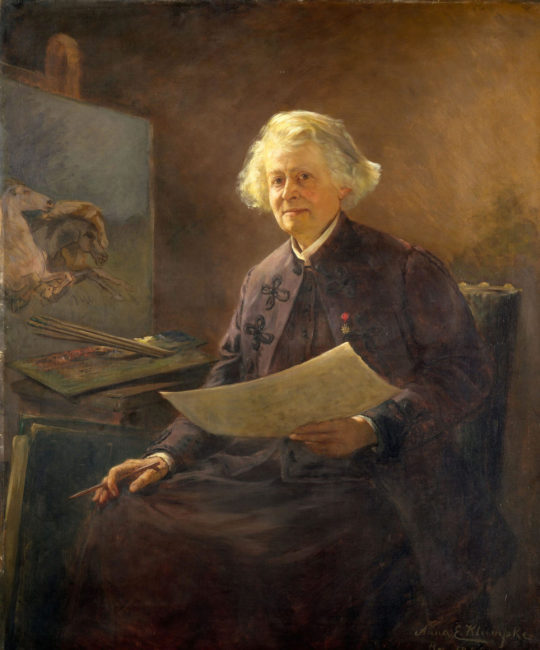
Rosa Bohneur grew up in a fairly wealthy family, thanks to the financial support of her mother's adoptive father. But when her mother's father died, the family was left without any such support, and fell into dire poverty. When Rosa was 11, her mother died, which deeply traumatised her. She kept a lifelong admiration for her mother.
In 1836, at the age of 14, she met Nathalie Micas, who became her lover. Only Nathalie's death 53 years later separated them.
Her father remarried in 1842 to Marguerite Peyrol, with whom he had a last son, Germain, who would also become a painter. Rosa Bonheur did not get on well with her stepmother and when her father died in 1849, she left the family home to live with the Micas.
After her mother's death, Rosa Bonheur went to primary schools, was apprenticed as a dressmaker and then went to boarding school. Eventually her father took her into his workshop, where her artistic talents were revealed. He was her one and only teacher. Gradually, she developed a passion for animal art, which became her speciality.
She exhibited for the first time, at the age of 19, at the Salon of 1841. She won a 3rd class medal at the Salon of 1845, and a 1st class medal (gold) at the Salon of 1848. This award enabled her, at the age of 26, to obtain a commission from the State to produce an agrarian painting (paid 3,000 francs). The painting resulting from this state commission, "Labourage nivernais" was supposed to go to the Musée des Beaux-Arts in Lyon. But it was so successful at the 1849 Salon that the Beaux-Arts department decided to keep it in Paris, at the Musée du Luxembourg. After Rosa Bonheur's death, the work went to the Louvre, before being transferred to the Musée d'Orsay in 1986.
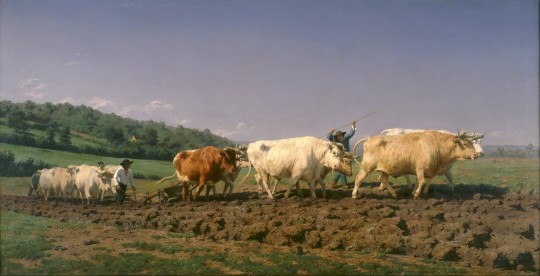
When her father died in March 1849, Rosa Bonheur replaced him as director of the École impériale gratuite de dessin pour demoiselles (or École gratuite de dessin pour jeunes filles). She remained in this position until 1860: ‘Follow my advice and I'll turn you into Leonardo da Vinci in skirts’, she often told her pupils.
In 1860, she moved to a huge house in By, where she had a huge workshop built, and ample space for her animals. One of her relatives wrote: “She had a complete menagerie in her house: a lion and a lioness, a deer, a wild sheep, a gazelle, horses, etc. One of her pets was a young lion she let run around. My mind was freer when this leonine animal died".
In June 1864, Rosa was visited by Empress Eugenie, who invited her to lunch at the Château de Fontainebleau with her husband. The following year, Eugenie returned to see her, to present her with the Legion d'honneur herself. Rosa is the ninth woman and the first artist to receive this distinction. About this, The Empress said :
“At last, you've been knighted. I am delighted to be the godmother of the first woman artist to receive this high distinction. I wanted the last act of my regency to be devoted to showing that, in my eyes, genius has no sex."
She was also the first woman to be made an officer in this order, in April 1894 (first female officer of the Legion d'honneur).
Rosa traveled extensively with her lover Nathalie, herself a painter and mechanical enthusiast (she invented and patented a railway braking system), and painted many pictures inspired by her travels.
In 1889, Nathalie died after some 50 years together. It was then that Rosa expressed her regret at not having been able to marry her.
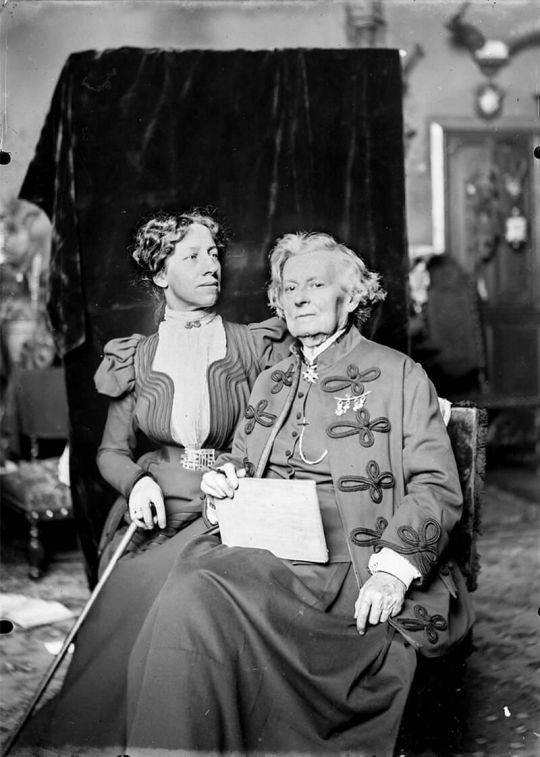
After Nathalie's death, Rosa met Anna Klumpe, a talented American painter. The two women moved in together some time later.
Rosa Bohneur died of pulmonary congestion in 1899, without having completed her last painting, “La foulaison du blé en Camargue”, a monumental canvas she had planned to exhibit at the 1900 Universal Exhibition.
She is buried in Père Lachaise cemetery, alongside Nathalie, her parents and Anna (who died years after her). She left her entire fortune to Anna, who, in 1908, published a biography of Rosa Bonheur and created a Rosa-Bonheur prize at the Société des artistes français. The Société des Artistes français posthumously awarded her the Medal of Honor shortly after her death.
Rosa could have had military honors at her funeral, but she specified in her will that she did not wish this.
There's a lot of interesting things to say about Rosa, her art and her history, so I suggest you do some research on her! She was a very talented and strong-willed woman who had a huge impact on French art and left a considerable cultural legacy.
Here are some of her paintings :
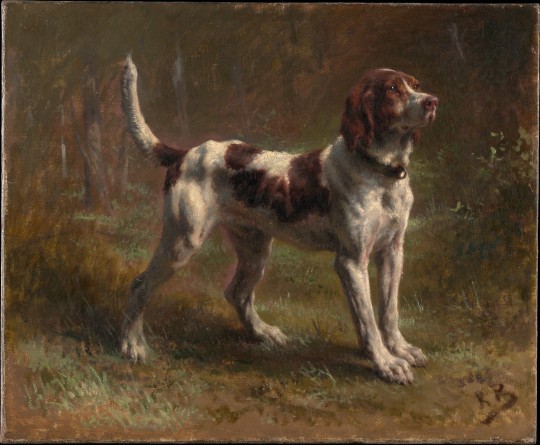
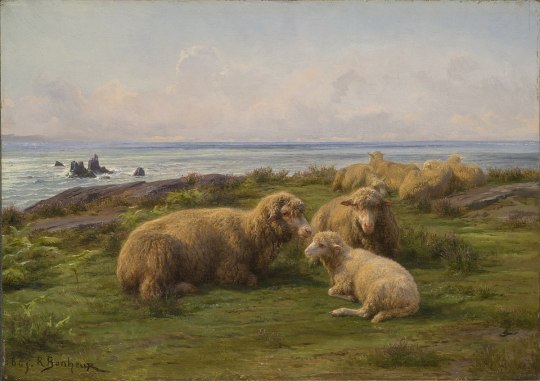
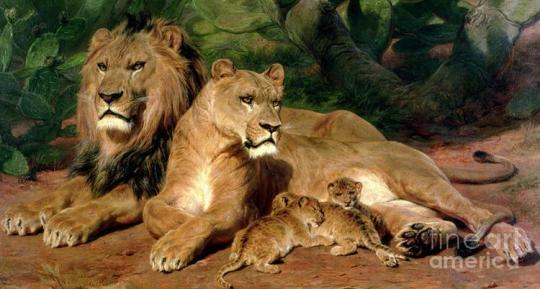
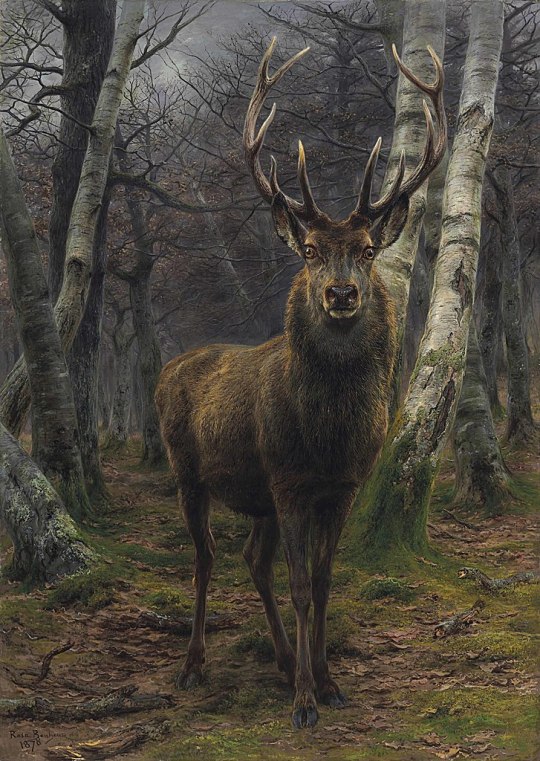
I personally love them ! I am not a painting expert, I just find them sooo pretty.
See you tomorrow :)
#lesbian#lesbian pride#pride#pride month#female homosexual#female homosexuality#rosa bonheur#french art#painting#art#lesbian history
217 notes
·
View notes
Text
Pulcinelle - Fragmentation
“Victory is still within my grasp, Nathalie! I have no need for the minor miraculous! Victory is mine, victory is mine!” Gabriel shouted through his phone, tearing his atelier apart while he paced like a caged tiger.
The man had not rested for the slightest moment since the Chinese Miracle Box had been stolen from him, and his face wore the exhaustion like a coat of warpaint. Silvery gray hair fell over his brows in the haphazard manner of a battle-torn settlement, white banners of surrender tainted with ash as his eyes burned with a conqueror’s fury. And yet, he had conquered nothing. Monarch had crowned himself king with a power he no longer possessed.
Raising up a crumpled diagram to the air, Gabriel continued to roar and howl. “I know the frequencies of each Kwami’s power! With the traces of their energy recorded within me, I shall be able to replicate them!” The ruined king burst into a manic laughter, shaking the paper like an empty chalice as its brothers swirled across tables and laid in dead heaps on the floor. “With the immense power of Embodied Transmission, all of the minor miraculous will be recreated and under my control! Do you understand, Nathalie? I’ve won! I have won!”
Monarch Renatus - Alliance Rings
Alliance Rings shall be constructed of an alloy (hereby designated Alliance Alloy) of 50% Silver, 39.9999% Lutetium, 10% Scandium, and 0.0001% Miraculum. Miraculum powder shall be harvested independently and combined with Lutetium before the Alliance Alloy is synthesized. Miraculum powder will display properties similar to mica, giving Alliance Rings a faint purple sparkle that may be used as a marketable feature.
Miraculum charged Alliance Rings -> Instantaneous Akumatization -> Potent Transmission?
“Gabriel.“
“All I need is to convince Tomoe of this plan, and I’ll be—“
“Gabriel!” Nathalie was pinching her nose so hard she was half worried she would snap it off. “You had the Rabbit Miraculous with you, the first thing you should’ve done is gone back to save Emilie. We can’t keep helping you if you can’t help yourself!”
“This isn’t just about Emilie anymore!”
Gabriel began to choke at the sound of his own words, letting the phone drop to the floor. All at once, the room began to spin, the papers and charts around him like a sea of parchment with an ever-shifting gravity, no up nor down. He had to grasp the edge of the table to prevent himself from collapsing and remember, remember that it was all about Emilie and it would only ever be about Emilie. He had to remember the ghost she had become, picture his love slipping away and resolve beyond all means and measure to bring her back. It was about Emilie, and ergo everything was justified, nothing was his fault! Gabriel could swear he had never been at fault!
“Yeah,” Nathalie barked back. “I can tell.”
And so she ended the call.
—— Hours later, in another office… ——
“Where are they?”
Gabriel was not at all comfortable with the idea of admitting failure to Tsurugi Tomoe. “Where is what?” He stammered out, loosening his collar with a finger.
“The collection of minor miraculous,” she repeated herself. “You said you had them.”
“When did I ever say that? You must, uh… You must be mistaken, Tomoe.”
“At 21:08 last night exactly, I was greeted with an email in my personal inbox. Its contents were:”
Madam Tsurugi,
I am pleased to inform you that I have acquired the possession of fifteen minor miraculous this evening. I feel as though this may be beneficial to our plans for the Perfect Alliance Initiative, and would like to discuss alterations to our plans in the morning. As you know, these artifacts are highly powerful (albeit not what I am currently searching for), and I believe you will know the best course of action moving forward.
An earlier meeting later on this evening would also suit me, although I do plan on following this sudden turn of events up with a grand speech to Paris as a whole to highlight Ladybug’s catastrophic blunder. Please refrain from contacting me until after I have concluded this.
Signed, Gabriel Agreste
“…That must have been an automated message.”
“Do you take me for an idiot, Agreste?”
Gabriel swallowed hard, bringing his face into a taut closed smile that pushed his glasses further up his face. The cocktail of drugs he��d taken to restore himself was only making Tomoe’s face swim before him, her features blending into a blurry blobfish mush that he couldn’t stay still long enough to focus on. The sweat rolled down his face with the tempo of his twitching cheek.
“I can say with utmost certainty that—“
“That you take me for an idiot?”
“No!” Gabriel blurted out. “…That what transpired last night was due to circumstances beyond my control. I believe the culprit we should turn our attentions towards is my nephew, Felix.“
“The fourteen year old boy?”
Gabriel swallowed again, following the action up with a quiet, nervous laughter. Of course it had to be the most ridiculous thing, for a boy less than a third Gabriel’s age to defeat him, but there was simply no other leads! Gabriel could picture that twerp now, cackling to himself as he sifted through the jewels rightfully stolen for Gabriel, crying to his mother about how innocent he was and how his uncle deserved to be robbed like this! But Gabriel Agreste would not take this slight standing down, not for a moment. Just as Tomoe had put it, Felix was but a small defenseless child.
“…Yes.”
“I see no reason in working with you any longer if teenagers can surpass you in competence,” Tomoe stated coldly, rising from her chair.
Gabriel slammed his hand down on the desk, the sweat from his palm graying the slick white sheen on the white wood.
“One last gamble, Tomoe. I have one last gamble.”
Gabriel fished out his brooch from underneath his jacket lapel, holding it up to the light. To the untrained eye, the center of the brooch was a cabochon of charoite, dark streaks clouding the surface of the gem. From its back shot out four spokes, the top two longer than the bottom: Pearlescent, shimmering nacre reflecting tones of lilac and blush pink. Silver veins ran up each wing tenderly, so thin they were hard to even notice. Perfect, invisible segments, tapering off at the ends of each wing into immaculate points.
“Feel its power, Tomoe,” Gabriel panted, leaning onto the desk. “This is all we have ever needed! Imagine even an ember of this power flowing through the alloy in every ring! Even the smallest pinch of this brooch as a component, and I will have every customer of yours as my minions.”
Tomoe slowly sat herself back down, keeping a hand on the table to steady herself.
“And how do you plan on accomplishing this?”
Gabriel’s laugh was hoarse and already sickly, his grasp on the brooch so tight the lower wings began to poke into the flesh of his hand.
“If there’s anything I know intimately, Tomoe, it is that a miraculous can break,” he replied. “And if I can even shatter a single wing of this brooch, I can redistribute its power as I see fit.”
taglist: @notchocostrwberry @beezonia @silliersiluriforme @lemons-taste @pyrusinc @wuhuislandconspiracy
#butterfly only alliance rings!!!!!!#gabriel agreste#mlb gabriel#ml gabriel agreste#nathalie sancoeur#mlb nathalie#tomoe tsurugi#miraculous fanfic#miraculous lb#butterfly miraculous#mlb s5#miraculous fandom#pulcinelle#miraculous ladybug
36 notes
·
View notes
Note
Hey ! I love your blog, you're a great source of inspo for writing.
I know you're more into the XVIIIth century but I would like to write a fanfic that take place at the end of the XIXth century in France ! Do you happen to have any queer history books on this era ? You seem like the kind of person that would know.
Thank you so much !! Have a great day
Thank you I’m glad you enjoy my blog 😊.
Unfortunately late 19th century really isn’t my strong suit. The only book I’ve read that’s about that period in France is Rosa Bonheur: The Artist's (Auto)Biography by Anna Klumpke. Rosa Bonheur was a famous painter who often wore men’s clothes. She lived with her partner Nathalie Micas for most of her life. After Nathalie’s death she met Anna Klumpke and they lived together until Rosa’s death. The book is written by Anna based on the stories that Rosa told her about her life as well as about her own memories of Rosa. It’s a great read if you’re interested in Rosa Bonheur but probably not very helpful if you want a more general look into French queer history of the period.
Maybe someone else can recommend something?
4 notes
·
View notes
Text
Rosa Bonheur
https://www.unadonnalgiorno.it/rosa-bonheur/

Rosa Bonheur, artista francese del XIX secolo, autrice di memorabili ritratti di animali, è stata la prima donna insignita della Legion d’Onore sebbene la storia dell’arte tenda a dimenticarla.
Dichiaratamente omosessuale, libera e indipendente, è stata tra le prime donne a indossare i pantaloni. Per farlo, doveva chiedere un’autorizzazione alle autorità che, ogni sei mesi, era costretta a rinnovare.
Nata col nome di Marie Rosalie Bonheur, il 16 maggio 1822 a Bordeaux, era la figlia maggiore del pittore Raymond Bonheur e di Sophie Marquis.
Ai suoi tempi le donne non potevano frequentare le Scuole di Belle Arti e il padre fu il suo maestro e quello dei fratelli e sorelle.
Invece di andare a copiare i quadri del Louvre preferiva stare in campagna e frequentare le fiere di animali che adorava.
Espose per la prima volta nel 1841, a diciannove anni al Salon di Parigi. A ventisei vinse la sua prima Medaglia d’oro, tra artisti come Corot, Ingres e Delacroix.
Per trovare l’ispirazione girava per i mercati di animali e i macelli indossando pantaloni, coi capelli corti e un sigaro in bocca per confondersi tra la folla.
Il suo quadro Aratura nelle campagne di Nevers, del 1949 è oggi esposto al Museo d’Orsay.
La fama internazionale era arrivata con La fiera di cavalli, arrivata al Metropolitan Museum di New York nel 1887, ancora oggi uno dei quadri più apprezzati della struttura.
La sua fortuna artistica è stata molto legata al mercato inglese, era molto apprezzata dalla regina Vittoria, e a quello statunitense.
È stato un raro esempio di artista che è riuscita a guadagnare in vita con le sue opere. Riuscì infatti a comprare il castello di By, a Thomery, vicino Fontainebleau, dove allestì il suo atelier e organizzò gli spazi per i suoi animali. Ci viveva con il suo primo amore, Nathalie Micas, anch’ella pittrice, conosciuta quando aveva quattordici anni da cui non si separò mai sino alla morte di lei, avvenuta nel 1889.
Allevava animali esotici e coltivava le sue passioni, musica, letture, teatro, ma anche sigari, caccia, cavalli. Sezionava i cadaveri degli animali per studiarli meglio.
Riceveva scrittori come Victor Hugo, Gustave Flaubert, i musicisti più famosi dell’epoca, Georges Bizet, Jules Massenet, Charles Gounod, appassionata d’opera, si recava spesso Parigi per assistere agli spettacoli.
Anche Buffalo Bill, che aveva conosciuto quando aveva visitato l’accampamento del Wild West Show, lo spettacolo che portava in giro per l’Europa, dove aveva visto per la prima volta i bisonti e altri animali esotici. Dal loro incontro nacque un celebre ritratto a cavallo dell’ospite americano, che le aveva donato un abito dei nativi visibile ancora oggi nella ex dimora dell’artista.
Nel 1865 è stata insignita della Grande Croce della Lègion d’Honneur dall’imperatrice Eugénie, moglie di Napoleone III, che aveva visitato il suo atelier e insistito per poterle consegnare la più alta onorificenza francese.
Anni dopo la scomparsa di Nathalie, si innamorò della per la pittrice statunitense Anna Klumpke, con ha vissuto fino alla morte e che è diventata la sua erede universale.
Ha lasciato la terra il 25 maggio del 1899 nel Castello di By. È sepolta a Parigi nel cimitero di Père-Lachaise.
I quadri, gli acquarelli, i bronzi e le incisioni presenti nel suo studio, così come la sua collezione personale, furono venduti alla galleria Georges Petit, a Parigi, nel 1900. Oggi il suo atelier è aperto al pubblico come Musée de l’atelier Rosa Bonheur a Thomery.
La sua biografia è stata scritta, nel 1908, da Anna Klumpke, la sua ultima compagna.
Nel 2022 per il bicentenario della sua nascita è stata allestita una mostra al Museo di Belle arti di Bordeaux e successivamente al Musée d’Orsay.
Nel suo castello, ora ribattezzato Château Rosa Bonheur, l’attuale proprietaria si batte per far riscoprire l’opera della pittrice e valorizzare la dimora che contiene molti documenti d’archivio ancora inediti rimasti conservati nei solai e magazzini e che, poco a poco, vengono studiati per arricchire la conoscenza di una donna emblematica della sua epoca la cui memoria non deve andare persa.
Si stima che al momento della sua morte al castello fossero presenti circa 4.500 opere. Grazie alle lastre fotografiche di Anna Klumpke, scoperte nei solai, si è potuto ricostruire in parte un inventario delle opere scomparse. Le immagini sono state il cuore dell’esposizione Le Musée des oeuvres disparues che presentava un centinaio di opere inedite della pittrice rivelandone aspetti meno conosciuti come le caricature, la pittura storica e paesaggistica, le illustrazioni di leggende inglesi.
Nel castello dove ha abitato è possibile dimorare e godere del meraviglioso giardino dove teneva i suoi amati animali.
3 notes
·
View notes
Text
Jackie (2016)
Directed by Pablo Larrain
Cinematography by Stéphane Fontaine
Starring Nathalie Portman, Peter Sarsgaard, Greta Gerwig, Billy Crudup and John Hurt




"The characters we read about on the page end up being more real than the men who stand beside us."
3 notes
·
View notes
Video
vimeo
Lanzamiento AFA Home & Away ⭐️⭐️⭐️ from Maro Margulis on Vimeo.
The champions have new Jerseys!
Advertiser: Adidas Football Creative agency: newcycle Production: newcycle Partners: Mica Koretzky, Andy Ostrofsky, Dan Stolar & Jon Levi Global General Leader in newcycle: Mica Koretzky General Creative Leader: Mica Koretzky & Tom Romano Account Leader: Daniela Galarza Design Leader: Sebastián Valencia Viana Digital Production Leader: Marianela Webb Project Manager: Agustina Bossetti & Florencia Innocenti Digital Production Project Coordinator: Aldana Gómez Digital Production Coordinator: Micaela Bajar Creative team: Nathaly Bosch & Luiza Vale. Design team: Nicolle Mellone Head of production: Andy Ostrofsky Producers: Cristian Izzi
Film Director: Felipe Escalada Illustration & Animation: Maro Margulis
Animation Assistant: Denise Bongiorno
Edition Team: Lucas Coppolecchia & Sebastián Fasanelli
Music production: Leonardo Martinelli
Actor’s director: Martín Cruz Color treatment: Francisco Palazzo Sound treatment: Ezequiel Martínez
0 notes
Text

Bonheur no comparison
Anna Elizabeth Klumpke, Rosa Bonheur, 1898, Metropolitan Museum of Art
Anna Elizabeth Klumpke (1856 -1942) was an American portrait painter best known for her portraits of famous women. Rosa Bonheur (1822-1899) was widely considered to be the most famous female painter of the nineteenth century. She lived with her first partner, Nathalie Micas, for over 40 years until Micas' death, and later began a relationship with Klumpke.
#art history#art history memes#dad jokes#punny#puns#punsarelikeonions#art meme#women in art#women artists#museum nerd#pride month
0 notes
Photo

Avui parlarem del vídeo de l'infermera del C1, i compartirem les vivències d'una mare ocella durant 55 dies, és el dia Mundial del Benestar mental per adolescents, comentarem les últimes notícies del món del cine i felicitarem artistes com Bryce Dallas Howard, Daniel Craig, Rebel Wilson, Nathalie Emmanuel, Bon Jovi i Becky G! I com sempre, també tindràs curiositats, anècdotes, veurem una broma divertida a l'IBAI i en Matxi aprendrà una mica de català. No et perdis aquesta nova entrega d'Un home 10! Vídeos a: Youtube.com/JauTV Directes a: twitch.tv/jaufibla I molt més a: jaumesclub.com (en Barcelona, Spain) https://www.instagram.com/p/CpnMbtkNj9B/?igshid=NGJjMDIxMWI=
0 notes
Text

Lou Gala incarne la peintre Nathalie Micas dans l'épisode consacré à Rosa Bonheur le 24 octobre 2022 sur France 3
Rosa Bonheur la fée des animaux !
1 note
·
View note
Text

25 notes
·
View notes
Note
Random question, what do you think is the most iconic queer photo?
I love this question but it's so hard to pick an answer! But I love photos of queer people all throughout history just living their lives. Here's a selection:

Crow batée Ohchiish (Osh-Tisch) left and unknown Crow individual, from Will Roscoe’s Changing Ones: Third and Fourth Genders in Native North America

Freddie Mercury and his partner Jim Hutton
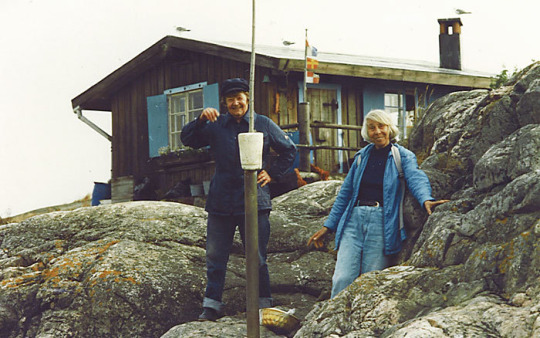
Finnish writer and artist Tove Jansson (right) and her partner Tuulikki “Tooti” Pietilä

Workers in Alice Anderson's 1920s 'all-female' garage in Australia
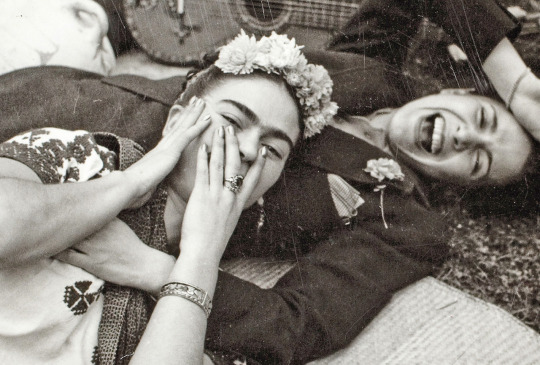
Mexican artist Frida Kahlo (left) and another woman, possibly Chavela Vargas

US politician Harvey Milk (with the long hair) and his partner Scott Smith

French artist Rosa Bonheur (right) and her partner, Nathalie Micas

British trans race-car driver Roberta Cowell
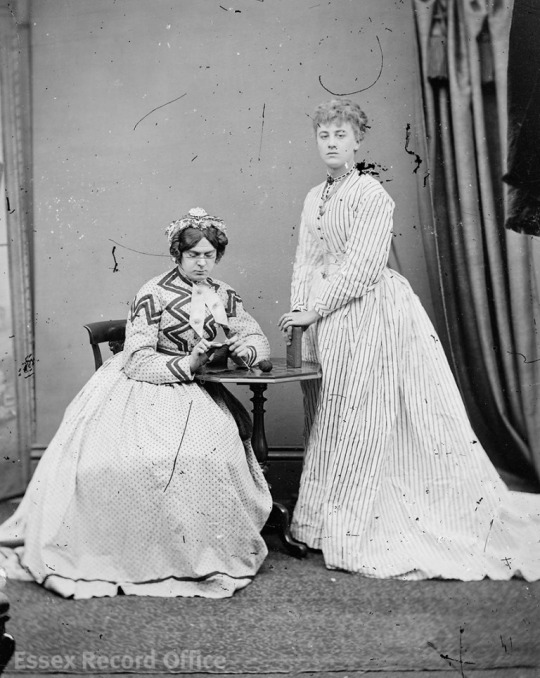
British trans-feminine actors Fanny Park (left) and Stella Boulton

Marsha P. Johnson
9K notes
·
View notes
Photo

From the National Museum of Wildlife Art:
June is National LGBTQ+ Pride Month. From antiquity to the present, LGBTQ+ artists have made invaluable contributions to the art world. Many LGBTQ+ artists have taken up animals and nature as subject matter. In fact, the green stripe on the original Pride flag stood for nature. We are sharing information about some of the LGBTQ+ advocates and artists in our collection to celebrate not only the work of LGBTQ+ artists everywhere, but also the relationship between the LGBTQ+ community and the natural world. Rosa Bonheur Regarded as one of the greatest women artists of all time and commercially successful as a painter in a male-dominated field in her lifetime, Rosa Bonheur regularly broke social conventions of the day. She received special permission to wear pants for practical purposes, as most of her art focused on animals and long skirts were impractical for trudging through grassy and muddy fields with her painting supplies. However, even when not painting, she would often wear shirts, trousers, and ties instead of dresses. According to historian Mary Blume, Bonheur lived with her partner Nathalie Micas for 40 years (whom she described as her wife and next to whom she was buried after her own death) and with American artist Anna Elizabeth Klumpke, who inherited Bonheur’s estate after she died. Bonheur’s “King of the Forest” is currently on display at the museum. . Rosa Bonheur (French, 1822 – 1899), “King of the Forest,” 1897. Pastel on Linen. 60 x 44 inches. Purchased with funds generously donated by the Robert S. and Grayce B. Kerr Foundation. National Museum of Wildlife Art.
646 notes
·
View notes
Photo

Continuing our Rosa Bonheur weekend visiting the artist’s tomb at Pere Lachaise cemetery, Paris. She shares her tomb her companion of forty years Nathalie Micas, and also American artist Anna Klumpke. Klumpke would be the sole inheriter of Bonheur’s estate. She would do everything to preserve the workshop and the works of Bonheur in order to pass them on to future generations. She also wrote the biography of Bonheur’s life and works. . . . #paris #perelachaise #rosabonheur (at Père Lachaise) https://www.instagram.com/p/Chwa9lpLXKq/?igshid=NGJjMDIxMWI=
2 notes
·
View notes
Quote
Nathalie would come to my little studio every morning. There we worked and lived, just the two of us, never opening the door to any flirting man.
Rosa Bonheur*
*From Rosa Bonheur: The Artist's [Auto]biography, p121 the english translation of Rosa Bonheur: Sa Vie, Son Oeuvre, the second part of which is written from the perspective of Rosa but by her companion Anna Klumpke. Anna explains that this part is “made up of my conversations with Rosa Bonheur. Since I’m convinced that this reader will be more interested in hearing words almost straight from her lips, I’ve transcribed them without breaks excepts for a few stories, quotations, and notes for the sake of clarity.”
#idk if I need this explanation but i feel like clarity is good?#the explanation is longer than the quote tho#anyway have this very gay quote#rosa bonheur#nathalie micas#queer history
10 notes
·
View notes
Text
muse bio links - tw looooong post

updated: 16 april 2023

KEY: ☆ main: you'll get one of these clowns if you don't specify otherwise
♡ primary: muses I usually have no trouble writing
♤ secondary: either newer muses or muses that take a bit more work
◇ tertiary: the picky muses
♧ by request: muses I don't write very often, but I can't seem to kick them out of my life
voice claims: here

☆☆☆ ADISSE ROSTTIEN - TES oc
fc: Annasophia Robb
♤ ALIA NANDI - SDV farmer oc
fc: Taapsee Pannu
♡♡ ANAÏS GUTIERREZ-GALLAGHER - fo4 sosu oc
fc: Christian Serratos
♤ ASA ŌGUMO GIANT SPIDER - monster prom oc
fc: Nathalie Emmanuel
◇ BAZ KOFFBA - TES oc
♡♡ OZAKI CHIRAWAN - JJK oc
fc: none
♤ BEAM - csm canon
fc: manga image
fc: Hange Zoë
♧ DAR'JHAN ROJVANADI - TES oc
fc: none
♤ DEACON - fo4 canon
fc: game image or Alan Tudyk
◇ ELLERA ROSTTIEN - TES oc
fc: Sophie Nélisse
♤ EMPYREAN - satanic clergy oc
fc: Chiara Scelsi
◇ ESSI DAVEN - witcher canon
fc: Rose McIver
♤ TENEDA FUMIYUKI - JJK oc
fc: Orochimaru
♧ GLORY - fo4 canon
fc: Alexandra Shipp
◇ HADREN ROSTTIEN - TES oc
fc: Saoirse Ronan
◇ HANAMI - JJK canon
fc: manga image
♡♡ HORNJOLF IRONBLACK - TES oc
fc: Richard Hibbard
♤ UMINO IRUKA - naruto canon
fc: manga image
◇ ITZLI DOMÍNGUEZ TECHALOTZI - satanic clergy oc
fc: Yalitza Aparicio
◇ JONI SNYDER - SDV oc
fc: Chloe Nørgaard
♡♡ JYSPOLWYNNI - TES oc
fc: Helena Greyhorse
♧ KRAGLIN OBFONTERI - bl crossover/canon
fc: Sean Gunn
♤ LOREE BAXTER- stranger things oc
fc: Birdy
♡♡ MAGGIE BROCKHOUSE - RDR2 oc
fc: Ashley Callingbull
♡♡ DAIGO MAYUMI - jjk oc
fc: Tae Takemi
◇ MICA KÖNIG - modern horror oc
fc: Julia Mertin
♧ MAD MIKE OEHLENSCHLAGER - BL barely canon
fc: Stephen R. Hart
◇ MOUNTAIN - satanic clergy canon
fc: Goran D. Kleut
♧ MR. TORGUE - BL canon
fc: game image
♡♡ MURPHY - fo4 oc
fc: Scarlett Simoneit
♡♡ NOAH SOKOLOW - fo4 oc
fc: Ben Schnetzer
♤ OKAGIMOTO NEZUMI - naruto oc
fc: Jade from MK
♧ OCVIST THE DESTROYER - witcher canon
fc: gwent image
♤ ONNICKA RIIS - modern horror oc
fc: Noor Schauten
◇ PRUDENCE ROCHESTER - BL oc
fc: Sibyl Buck
◇ REMNI YSO - TES oc
fc: Jana Knauerová
◇ ROCHELLE PERREAULT - monster prom oc
fc: Ali Skovbye
♤ ISHIBASHI RYUKO - naruto oc
fc: Skarlet from MK
♤ SALOMÉ GUEVARA - SDV oc
fc: Laura Isabel Ramirez
♤ SHANE LANDAU - SDV canon
fc: Ari Stidham
◇ SIONED - fo4 oc
fc: Demi Moore
☆☆☆ TEMPEST - satanic clergy oc
fc: Charleen Weiss
♤ THARA MAKHDOOM - satanic clergy oc
fc: Shanina Shaik
◇ TIMOFEI KORNEV - satanic clergy oc
fc: Eric Idle
♤ UN-KYONG - satanic clergy oc
fc: Sora Choi
♤ VERASTIAN SINTOR - TES oc
fc: Josh Ritter
☆☆☆ WALKER REID - BL oc
fc: Masha Gorâčëva
◇ YARPEN ZIGRIN - witcher canon
fc: Jarosław Boberek
♤ YELIZAVETA ERDENEBAT - modern horror oc
fc: Yasmin Ammosova
◇ GAKUGANJI YOSHINOBU - JJK canon
fc: manga image
♡♡ ZECHARIAS H.E. BAILEY - RDR2 oc
fc: Jake Smith

3 notes
·
View notes